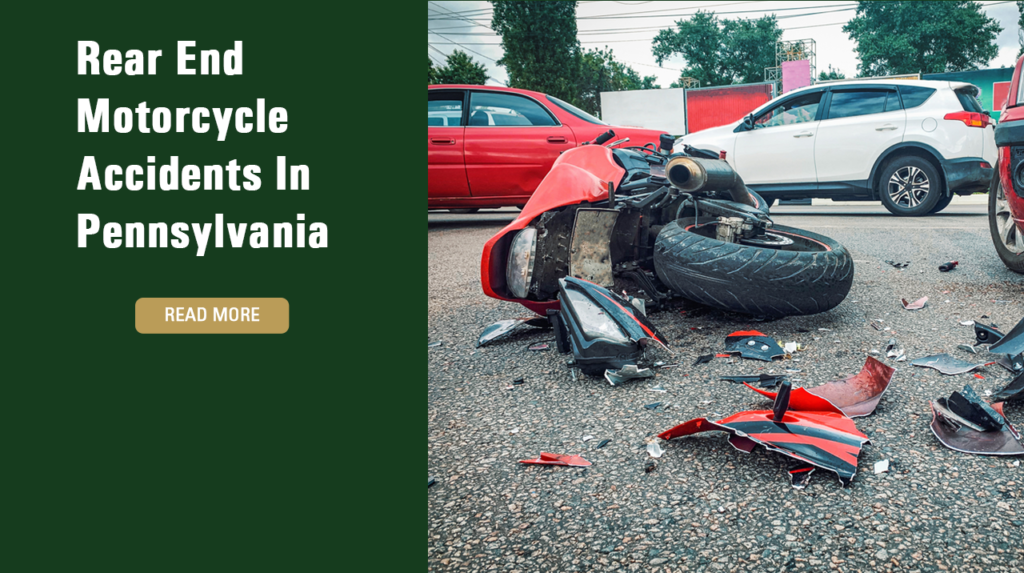Rear End Motorcycle Accidents In Pennsylvania

Even if you always exercise caution when you ride your motorcycle, you can’t control the actions of other motorists. In some cases, a motorist will be speeding or not paying attention and will crash into a motorcycle in front of the motorist’s car. Rear-end motorcycle accidents in Pennsylvania are frequently serious. While a rear-end car collision might result in property damage and minor injuries, a rear-end motorcycle crash can have catastrophic consequences for both the bike and the motorcyclist. Here is some information about rear-end motorcycle crashes from the motorcycle accident injury lawyers at Raynes & Lawn.
What Happens In A Rear-End Motorcycle Accident?
A rear-end accident happens when a motorist hits another vehicle in front of it. In the case of a rear-end motorcycle collision, a trailing vehicle will strike a motorcycle in front of it, or a trailing motorcycle will collide with a vehicle or another motorcycle in front of it.
Rear-end crashes can be very dangerous and result in significant damage and injuries and can occur for many reasons, including the following:
- Tailgating or following too closely
- Speeding
- Traveling too fast for the conditions
- Distracted driving
- Driving while impaired by alcohol or drugs
Possible Injuries Sustained In A Rear-End Motorcycle Accident
Motorcycles lack the types of safety features that are standard in many cars. They also have a lower weight and don’t include a protective cab around the riders. Because of these differences, motorcycle accidents frequently result in serious injuries.
Some of the types of injuries that can occur in rear-end motorcycle accidents include the following:
- Traumatic brain injuries from being thrown from the bike or falling from it even when wearing a helmet
- Neck and spinal cord injuries are caused when the spine absorbs the impact, resulting in potential paraplegia or quadriplegia
- Internal organ damage resulting in internal bleeding and potential death
- Fractured limbs
- Amputations when the motorcyclist is run over by the rear vehicle and dragged
- Eye injuries caused by the shock of the crash dislodging the optic nerve
- Burns
- Road rash
- Lacerations
- Puncture wounds
- Death
It is common for motorcyclists to receive multiple types of injuries in rear-end collisions.
How A Motorcycle Accident Attorney Can Help
While you are not required to hire a motorcycle accident attorney, doing so can make it much likelier that you will succeed with your claim. If you were seriously injured in a rear-end accident caused by another motorist, you can take legal action against the at-fault driver. A competent motorcycle accident attorney can help in multiple ways as described below.
1. File Your Claim Within The Statute of Limitations
Under 42 Pa.C.S. § 5524, you must file your lawsuit no later than two years after your collision. An attorney can ensure that your complaint is filed properly and on time. If you don’t meet this deadline, your claim will be time-barred. While you have two years, it is best for you to retain a lawyer as soon as possible after your crash. Doing so will help your attorney to gather and preserve important evidence to support your claim.
2. Properly Value Your Claim
Many motorcycle accident victims are unsure about how much their claims might be worth. The value of a claim can greatly vary and will depend on the specific facts and circumstances of the case. If you don’t know how much your claim is worth, you might accept a low settlement offer from an insurance company that will not adequately cover your losses. A good motorcycle accident lawyer can properly value your claim, including the likely value of both your economic and non-economic losses, so that you can evaluate any settlement offers the insurance company might make.
3. Make A Liability Determination
Determining liability in a rear-end motorcycle crash is crucial. Your attorney will carefully investigate your case to determine who was at fault in causing the accident. In some cases, more than one party might share liability. If more than one party contributed to your accident, you will want to name each responsible party as a defendant in your lawsuit. If you shared some of the fault, that is also important because your potential award will be reduced by the percentage of fault attributed to you.
4. Help You Understand Your Rights
An attorney can help you understand your rights when you have been injured because of the negligence of someone else. In the case of a rear-end motorcycle crash, you have the right to sue the at-fault driver for your economic and non-economic losses caused by the accident and your injuries. Your attorney will help you understand the relevant statutes and court decisions that could affect your claim. You will have the right to accept a settlement offer or to take your case to trial. Your attorney will help to guide you throughout the process so that you know what to expect.
5. Advocate For Maximal Compensation
Your attorney will do everything possible to pursue maximal compensation for your losses. He or she might work with experts and investigators to gather evidence of the other driver’s liability and use that information to negotiate with the insurance company on your behalf. After your lawyer values your claim and determines liability, he or she will also identify all potential sources of recovery. If the insurance company refuses to offer a fair settlement, your attorney might take your case to trial to recover compensation in an amount that fully covers your losses.
Contact A Motorcycle Accident Injury Lawyer
If you or your loved one sustained serious injuries in a rear-end motorcycle collision because of someone else’s negligence, you have the right to pursue compensation from the party or parties who caused your accident and injuries. Contact Raynes & Lawn today for a free case evaluation by calling 1-800-535-1797.

For the general public: This Blog/Website is made available by the law firm publisher, Raynes & Lawn, for educational purposes. It provides general information and a general understanding of the law but does not provide specific legal advice. By using this site, commenting on posts, or sending inquiries through the site or contact email, you confirm that there is no attorney-client relationship between you and the Blog/Website publisher. The Blog/Website should not be used as a substitute for competent legal advice from a licensed attorney in your jurisdiction.
For attorneys: This Blog/Website is informational in nature and is not a substitute for legal research or a consultation on specific matters pertaining to your clients. Due to the dynamic nature of legal doctrines, what might be accurate one day may be inaccurate the next. As such, the contents of this blog must not be relied upon as a basis for arguments to a court or for your advice to clients without, again, further research or a consultation with our professionals.

